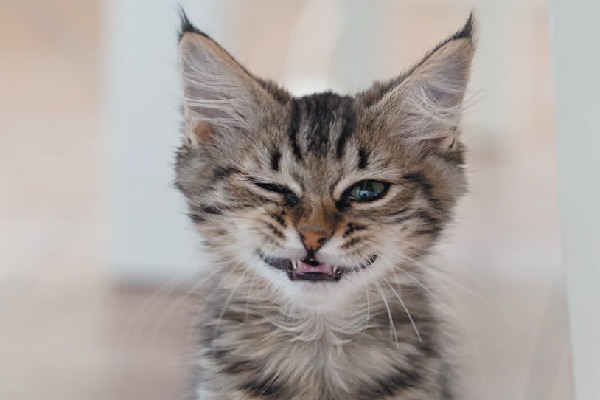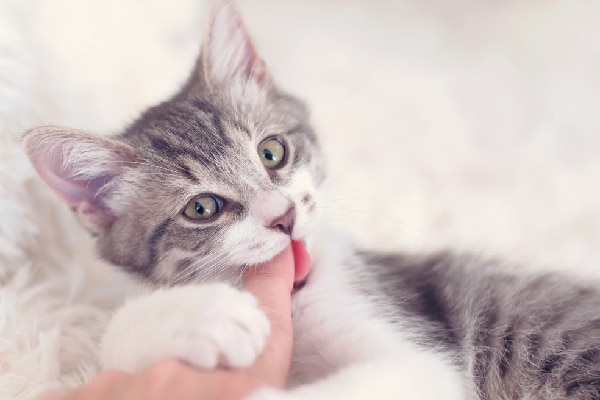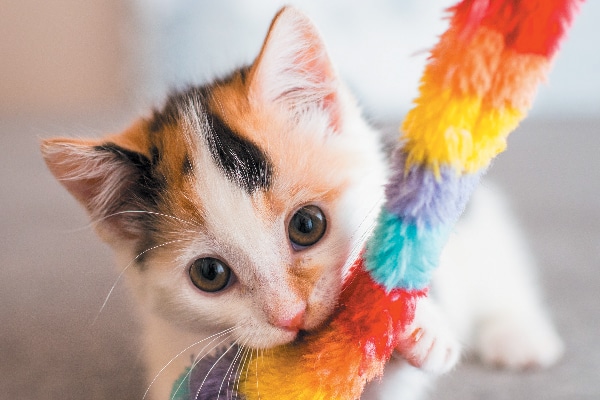There’s no end to the plethora of internet videos of adorable kittens doing all the things adorable kittens do. But now that you’ve brought home the too-cute, tiny feline companion of your dreams, you’re about to find out that those short clips don’t come close to revealing the whole truth of life with a tiny ball of fur, energy, teeth and claws. To help you keep calm and companioning on amid the whirlwind and the wonder, read on to discover the kitten behaviors you can really expect when you’re expecting to share your life with a kitten.
5 common kitten play behaviors

- Pouncing on toys, toes and “prey”
- Nibbling at hands, fingers, wool
- Batting toys
- Jumping side to side
- Climbing vertically, perching high
When do kittens begin playing?

“As kittens approach weaning age, their playful personalities begin to shine through,” says Hannah Shaw, aka Kitten Lady, kitten rescuer, humane educator and animal advocate. “It’s always funny to watch kittens discover what their bodies can do through play.”
Playing behaviors typically start to emerge once kittens start eating meat, according to Hannah. At about 5 weeks of age, when their premolars emerge, is when she first introduces wet food, and that’s when “it’s like a light turns on in their head letting them know that they are, in fact, a tiny predator!” she says.
What kitten behaviors are actually hunting behaviors?
“Many of the common behaviors you see, like pouncing, biting and clawing, are actually hunting behaviors — the kittens are practicing their predatory prowess,” Hannah continues. “Hopping side-to-side, or crab walking, is something I see when kittens are introduced to an unfamiliar stimulus. This movement allows the kittens to get away while also keeping an eye on the potential threat. While it doesn’t feel the best, it’s pretty common for kittens to also practice climbing by clawing their way up pant legs in an attempt to get a bird’s-eye view.”
Don’t classify kitten behaviors as ‘good’ or ‘bad’

Avoid the temptation to classify kitten behaviors as black or white, “good” or “bad.” Instead, view them for the animal behaviors they are and understand that it’s your responsibility to show them what’s appropriate or not in the household. “There’s no such thing as a ‘bad’ kitten — kittens are learning and practicing normal, healthy behaviors of a predator species,” Hannah says. “Encourage them to explore their skills through these hunting behaviors, but do it in a way that doesn’t leave your hands or pants in tatters.”
Make sure you have the appropriate toys
First and foremost, never play using your hands as a target, as this teaches a kitten that it’s OK to bite and claw at human skin, Hannah says. “Instead, use kitten-appropriate toys to give them a desirable outlet for their aggression.” Also, provide access to scratching posts or other smaller cat trees to allow climbing skills practice time. “Cats want to be high up so they can observe the world beneath them, so giving them vertical space will help them feel confident and happy without them having to climb your body,” Hannah says. “The greatest thing a kitten caregiver can do is to give her plenty of enrichment and, most importantly, plenty of patience.”
Tell us: What are the silliest kitten behaviors that you’ve observed? What about the most baffling kitten behaviors?
Thumbnail: Photography ©Casey Elise Photography.
Ellyce Rothrock spent half her life with Flea, a Maine Coon who lived to be 21 and is missed every single day. She’s currently seeking a feline friend to manage Fritz and Mina, her German Shepherd Dog rescues. She’s lucky enough to live her passion for pets as a 25-year member of the pet media industry.
Editor’s note: This article appeared in Kittens, a special issue from Catster magazine. Look for Kittens on a newsstand near you!








